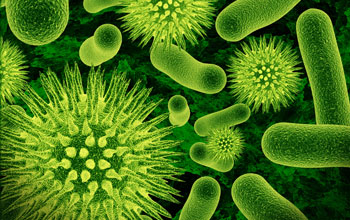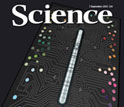News Release 12-161
New Research Suggests Bacteria Are Social Microorganisms
MIT scientists: Bacteria plays different social roles, including attacking and defending other bacteria

Researchers examined about 35,000 chemical reactions to determine the social roles of bacteria.
September 6, 2012
This material is available primarily for archival purposes. Telephone numbers or other contact information may be out of date; please see current contact information at media contacts.
New research from the Massachusetts Institute of Technology reveals that some unlikely subjects--bacteria--can have social structures similar to plants and animals.
The research shows that a few individuals in groups of closely related bacteria have the ability to produce chemical compounds that kill or slow the growth of other populations of bacteria in the environment, but not harm their own.
Published in the September 7 issue of the journal Science, the finding suggests that bacteria in the environment can play different social roles and that competition occurs not only among individual bacteria, but also among coexisting ecological populations.
The National Science Foundation, an independent federal agency that supports fundamental research and education across all fields of science and engineering, funded the research.
"Bacteria typically have been considered purely selfish organisms and bacterial populations as groups of clones," said Otto Cordero, a theoretical biologist and lead researcher on the paper. "This result contrasts with what we know about animal and plant populations, in which individuals can divide labors, perform different complementary roles and act synergistically."
Cordero and colleagues from MIT, along with researchers from the French Research Institute for Exploitation of the Sea and Woods Hole Oceanographic Institution in Massachusetts, studied whether population-level organization exists for bacteria in the wild.
They reasoned social structure can reduce conflict within populations of plants and animals and determine aggression towards competing biological populations. "Think of a population of lions in the Serengeti or a population of fish in a lake," said Cordero. But could the same be true for populations of bacteria?
"It is difficult to know what the environmental interactions really are, because microbes are too small for us to observe them in action," said Martin Polz, an organismic and evolutionary biologist at MIT and principal investigator for the Polz Microbial Ecology and Evolution Lab. "But our research provides strong evidence that antibiotics play a role in fending off competitors."
The researchers found evidence by looking at direct, aggressive competition between ecological populations of bacteria. They reconstructed a large network of bacterial fights--or antibiotic-mediated interactions--between bacteria from the ocean.
The scientists analyzed interactions called interference competitions, wherein bacteria produce antibiotics as a means of chemical warfare, to gain a competitive edge by directly hindering the survival of potential competitors.
This typically occurs when bacteria compete for the same portion of habitat.
The researchers assembled an all-against-all battleground for 185 closely-related, but distinct, members of an ocean-based family of bacteria called Vibrionaceae. They measured bacterial compounds produced by Vibrio isolates that directly antagonized other Vibrio isolates.
The framework provided Cordero and colleagues an opportunity to examine about 35,000 possible antibiotic-mediated interactions.
The researchers found that ecologically delineated bacterial populations act as socially cohesive units. "In these populations, a few individuals produced antibiotics to which closely related individuals in the population were resistant, whereas individuals in other populations were sensitive," said Cordero.
Thus, aggressive chemical reactions occur between, rather than within natural populations.
"It appears to be a group effort where individuals assume the role of antibiotic producers and hence defenders," said Polz. "Of course, competing groups could also produce antibiotics. It's a potential arms race out there."
"Those individuals that don't produce antibiotics can benefit from association with the producers, because they are resistant," added Cordero. "In other words, antibiotics have a social effect, because they can benefit the population as a whole."
The findings may help scientists answer questions about the natural role of antibiotics in human contexts.
"The research has the potential to bridge gaps in our understanding of the relationships between plants and humans and their non-disease- and disease-causing bacterial flora," said Robert Fleischmann, a program director in the Division of Biological Infrastructure for the National Science Foundation.
"We use antibiotics to kill pathogenic microbes, which cause harm to humans and animals," said Polz. "As an unfortunate side effect, this has lead to the widespread buildup of resistance, particularly in hospitals where pathogens and humans encounter each other often."
In addition, the results help scientists make sense of why closely related bacteria are so diverse in their gene content. Part of the answer, they say, is that the diversity allows the bacteria to play different social roles.
Social differentiation, for example, could mitigate the negative effects of two species competing for the same limiting resource--food or habitat, for instance--and generate population level behavior that emerges from the interaction between close relatives.
"Microbiology builds on the study of pure cultures," said Cordero, "that is genotypes isolated from their population. Our work shows that we need to start focusing on population based phenomena to better understand what these organisms are doing in the wild."
-NSF-
-
The researchers' work is described in the September 7, 2012 issue of the journal Science.
Credit and Larger Version
Media Contacts
Bobbie Mixon, NSF, (703) 292-8485, email: bmixon@nsf.gov
Program Contacts
Robert Fleischmann, NSF, (703) 292-7191, email: rfleisch@nsf.gov
Principal Investigators
Otto Cordero, Massachusetts Institute of Technology, email: ottoxcordero@gmail.com
Co-Investigators
Martin Polz, Massachusetts Institute of Technology, (617) 253-7128, email: mpolz@mit.edu
The U.S. National Science Foundation propels the nation forward by advancing fundamental research in all fields of science and engineering. NSF supports research and people by providing facilities, instruments and funding to support their ingenuity and sustain the U.S. as a global leader in research and innovation. With a fiscal year 2023 budget of $9.5 billion, NSF funds reach all 50 states through grants to nearly 2,000 colleges, universities and institutions. Each year, NSF receives more than 40,000 competitive proposals and makes about 11,000 new awards. Those awards include support for cooperative research with industry, Arctic and Antarctic research and operations, and U.S. participation in international scientific efforts.
Connect with us online
NSF website: nsf.gov
NSF News: nsf.gov/news
For News Media: nsf.gov/news/newsroom
Statistics: nsf.gov/statistics/
Awards database: nsf.gov/awardsearch/
Follow us on social
Twitter: twitter.com/NSF
Facebook: facebook.com/US.NSF
Instagram: instagram.com/nsfgov

